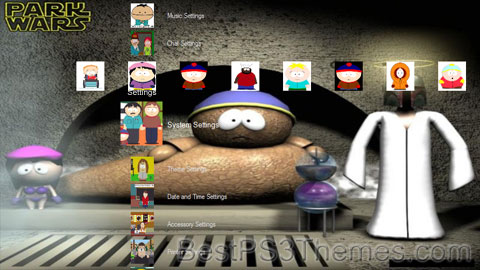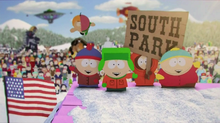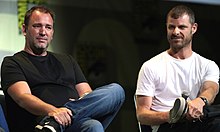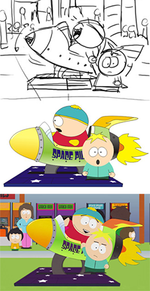South Park theme by jbell
Download: SouthPark_3.p3t

(10 backgrounds)
| South Park | |
|---|---|
 | |
| Genre | |
| Created by | |
| Developed by | Brian Graden |
| Showrunners |
|
| Voices of |
|
| Theme music composer | Primus |
| Composers |
|
| Country of origin | United States |
| Original language | English |
| No. of seasons | 26 |
| No. of episodes | 328 (list of episodes) |
| Production | |
| Executive producers |
|
| Producers |
|
| Cinematography | Kenny Gioseffi |
| Running time | 22 minutes[1] |
| Production companies |
|
| Original release | |
| Network | Comedy Central[nb 1] |
| Release | August 13, 1997 – present |
| Related | |
| The Spirit of Christmas | |
South Park is an American animated sitcom created by Trey Parker and Matt Stone and developed by Brian Graden for Comedy Central. The series revolves around four boys—Stan Marsh, Kyle Broflovski, Eric Cartman, and Kenny McCormick—and their exploits in and around the titular Colorado town. South Park also features many recurring characters. The series became infamous for its profanity and dark, surreal humor that satirizes a large range of subject matter.
Parker and Stone developed South Park from two animated short films, both titled The Spirit of Christmas, released in 1992 and 1995. The second short became one of the first Internet viral videos, leading to the series' production. The pilot episode was produced using cutout animation; the remainder of the series uses computer animation recalling the prior technique. Since the fourth season, episodes are generally written and produced during the week preceding its broadcast, with Parker serving as the lead writer and director.
Since its debut on August 13, 1997, 328 episodes of South Park have been broadcast. It debuted with great success, consistently earning the highest ratings of any basic cable program. Subsequent ratings have varied, but it remains one of Comedy Central's longest-running programs. In August 2021, South Park was renewed through 2027, and a series of television specials was announced for Paramount+, the first two of which were released later that year.[2][3] In October 2019, it was announced that WarnerMedia acquired exclusive streaming rights to South Park starting in June 2020 for HBO Max.[4] The series' twenty-sixth season premiered on February 8, 2023.[5]
South Park has received critical acclaim, and is included in various publications' lists of the greatest television shows. It has received numerous accolades, including five Primetime Emmy Awards and a Peabody Award. A theatrical film, South Park: Bigger, Longer & Uncut, was released in June 1999 to commercial and critical success, garnering an Academy Award nomination. In 2013, TV Guide ranked South Park the tenth Greatest TV Cartoon of All Time.[6]
Premise[edit]
Setting and characters[edit]
South Park centers around four boys: Stan Marsh, Kyle Broflovski, Eric Cartman and Kenny McCormick. The boys live in the fictional small town of South Park, located within the real-life South Park basin in the Rocky Mountains of central Colorado,[7] approximately a one-hour drive from Denver.[8] The town is also home to an assortment of other characters, including students, families, elementary school staff, and other various residents.[9] Prominent settings include South Park Elementary, various neighborhoods and the surrounding mountain range, actual Colorado landmarks, and the businesses along the town's main street, all of which are based on the appearance of similar locations in Fairplay, Colorado.[7][9] As one of the few television programs set in the Mountain West region that takes place outside the urban core of Denver, South Park frequently features the unique culture of the region, including cattle ranchers, Old West theme parks, snowy climates, mountaineering, Mormons, real-life Colorado locations such as Casa Bonita and Cave of the Winds, and many other regionally specific characteristics.
Stan is portrayed as an average American boy; however, he has many mishaps throughout the series. In the first 22 seasons, Stan lived in South Park, but in the episodes during and after season 22, Stan resided in Tegridy Farms. Kyle is Jewish, and his portrayal as one of the few such people in South Park is often dealt with satirically.[10] Stan is modeled after Parker, while Kyle is modeled after Stone. They are best friends, and their friendship, symbolically intended to reflect Parker and Stone's friendship,[11] is a common topic throughout the series. Cartman (as he is commonly referred to) is amoral and increasingly psychopathic, and is commonly portrayed as an antagonist. His staunch antisemitism has resulted in a progressive rivalry with Kyle.[10][12] Kenny, who comes from a poor family, tightly wears his parka hood to the point where it obscures most of his face and muffles his speech. During the first five seasons, Kenny died in almost every episode before reappearing in the next with no definite explanation. He was killed off in the fifth season episode "Kenny Dies", before being reintroduced in the sixth season finale, "Red Sleigh Down". Since then, Kenny is depicted as dying sporadically. During the first 58 episodes, the children were in the third grade. During the fourth season, they entered the fourth grade, where they have remained ever since.[13][14]
Plots are often set in motion by events, ranging from the fairly typical to the supernatural and extraordinary, which frequently happen in the town.[15] The boys often act as the voice of reason when these events cause panic or incongruous behavior among the adult populace, who are customarily depicted as irrational, gullible, and prone to overreaction.[7][16] They are frequently confused by the contradictory and hypocritical behavior of their parents and other adults, and often perceive them as having distorted views on morality and society.[9][17]
Themes and style[edit]
Each episode opens with a tongue-in-cheek all persons fictitious disclaimer: "All characters and events in this show—even those based on real people—are entirely fictional. All celebrity voices are impersonated.....poorly. The following program contains coarse language and due to its content it should not be viewed by anyone."[18][19]
South Park was the first weekly program to be rated TV-MA,[20] and is generally intended for adult audiences.[21][22][23] The boys and most other child characters use strong profanity, with only the most taboo words being bleeped during a typical broadcast.[9] Parker and Stone perceive this as the manner in which real-life small boys speak when they are alone.[24][25]
South Park commonly makes use of carnivalesque and absurdist techniques,[26] numerous running gags,[27][28] violence,[28][29] sexual content,[30][31] offhand pop-cultural references, and satirical portrayal of celebrities.[32]
Early episodes tended to be shock value-oriented and featured more slapstick-style humor.[33] While social satire had been used on the show occasionally earlier on, it became more prevalent as the series progressed, with the show retaining some of its focus on the boys' fondness of scatological humor in an attempt to remind adult viewers "what it was like to be eight years old".[10] Parker and Stone also began further developing other characters by giving them larger roles in certain storylines,[10] and began writing plots as parables based on religion, politics, and numerous other topics.[9] This provided the opportunity for the show to spoof both extreme sides of contentious issues,[34] while lampooning both liberal and conservative points of view.[9][16][35] Rebecca Raphael described the show as "an equal opportunity offender",[15] while Parker and Stone describe their main purpose as to "be funny" and "make people laugh",[36][37] while stating that no particular topic or group of people be exempt from mockery and satire.[16][32][38][39][40]
Parker and Stone insist that the show is still more about "kids being kids" and "what it's like to be in [elementary school] in America",[41] stating that the introduction of a more satirical element to the series was the result of the two adding more of a "moral center" to the show so that it would rely less on simply being crude and shocking in an attempt to maintain an audience.[36][37] While profane, Parker notes that there is still an "underlying sweetness" aspect to the child characters,[34] and Time described the boys as "sometimes cruel but with a core of innocence".[11] Usually, the boys or other characters pondered over what transpired during an episode and conveyed the important lesson taken from it with a short monologue. During earlier seasons, this speech commonly began with a variation of the phrase "You know, I've learned something today...".[42]
Development[edit]

Parker and Stone met in film class at the University of Colorado in 1992 and discovered a shared love of Monty Python, which they often cite as one of their primary inspirations.[43] They created an animated short entitled The Spirit of Christmas.[27] The film was created by animating construction paper cutouts with stop motion, and features prototypes of the main characters of South Park, including a character resembling Cartman but named "Kenny", an unnamed character resembling what is today Kenny, and two near-identical unnamed characters who resemble Stan and Kyle. Fox Broadcasting Company executive and mutual friend Brian Graden commissioned Parker and Stone to create a second short film as a video Christmas card. Created in 1995, the second The Spirit of Christmas short resembled the style of the later series more closely.[44] To differentiate between the two homonymous shorts, the first short is often referred to as Jesus vs. Frosty, and the second short as Jesus vs. Santa. Graden sent copies of the video to several of his friends, and from there it was copied and distributed, including on the internet, where it became one of the first viral videos.[27][11]
As Jesus vs. Santa became more popular, Parker and Stone began talks of developing the short into a television series about four children residing in the fictional Colorado town of South Park. Fox eagerly agreed to meet with the duo about the show's premise, having prided itself on edgier products such as Cops, The Simpsons, and The X-Files. However, during the meeting at the Fox office in Century City, disagreements between the two creators and the network began to arise, mainly over the latter's refusal to air a show that included a supporting talking stool character named Mr. Hankey. Some executives at 20th Century Fox Television (which was to produce the series) agreed with its then-sister network's stance on Mr. Hankey and repeatedly requested Parker and Stone to remove the character in order for the show to proceed. Refusing to meet their demands, the duo cut ties with Fox and its sister companies all together and began shopping the series somewhere else.[45][46][47]
The two then entered negotiations with both MTV and Comedy Central. Parker preferred the show be produced by Comedy Central, fearing that MTV would turn it into a kids show.[48] When Comedy Central executive Doug Herzog watched the short, he commissioned for it to be developed into a series.[27][49] Parker and Stone assembled a small staff and spent three months creating the pilot episode "Cartman Gets an Anal Probe".[50] South Park was in danger of being canceled before it even aired when the show fared poorly with test audiences, particularly with women. However, the shorts were still gaining more popularity over the Internet, and Comedy Central ordered a run of six episodes.[36][48] South Park debuted with "Cartman Gets an Anal Probe" on August 13, 1997.[51]
Production[edit]
Except for the pilot episode, which was produced using cutout animation, all episodes of South Park are created with the use of software, primarily Autodesk Maya.[52] As opposed to the pilot, which took three months to complete,[53] and other animated sitcoms, which are traditionally hand-drawn by companies in South Korea in a process that takes roughly eight to nine months,[27][35] individual episodes of South Park take significantly less time to produce. Using computers as an animation method, the show's production staff were able to generate an episode in about three weeks during the first seasons.[54] Now, with a staff of about 70 people, episodes are typically completed in one week,[27][34][35] with some in as little as three to four days.[55][56][57] Nearly the entire production of an episode is accomplished within one set of offices, which were originally at a complex in Westwood, Los Angeles, California and are now part of South Park Studios in Culver City, California.[49][53] Parker and Stone have been the show's executive producers throughout its entire history.[58] Debbie Liebling, who was Senior Vice President of original programming and development for Comedy Central, also served as an executive producer during the show's first five seasons, coordinating the show's production efforts between South Park Studios and Comedy Central's headquarters in New York City.[59][60] During its early stages, finished episodes of South Park were hastily recorded to D-2 to be sent to Comedy Central for airing in just a few days' time.[61] Each episode used to cost $250,000.[62]
Writing[edit]

Scripts are not written before a season begins.[63] Production of an episode begins on a Thursday, with the show's writing consultants brainstorming with Parker and Stone. Former staff writers include Pam Brady, who has since written scripts for the films Hot Rod, Hamlet 2 and Team America: World Police (with Parker and Stone), and Nancy Pimental, who served as co-host of Win Ben Stein's Money and wrote the film The Sweetest Thing after her tenure with the show during its first three seasons.[64][65] Television producer and writer Norman Lear, an alleged idol of both Parker and Stone, served as a guest writing consultant for the season seven (2003) episodes "Cancelled" and "I'm a Little Bit Country".[63][66][67] During the 12th and 13th seasons, Saturday Night Live actor and writer Bill Hader served as a creative consultant and co-producer.[68][69][70]
After exchanging ideas, Parker will write a script, and from there the entire team of animators, editors, technicians, and sound engineers will each typically work 100–120 hours in the ensuing week.[50] Since the show's fourth season (2000), Parker has assumed most of the show's directorial duties, while Stone relinquished his share of the directing to focus on handling the coordination and business aspects of the production.[27][71] On Wednesday, a completed episode is sent to Comedy Central's headquarters via satellite uplink, sometimes just a few hours before its air time of 10 PM Eastern Time.[27][72]
Parker and Stone state that subjecting themselves to a one-week deadline creates more spontaneity amongst themselves in the creative process, which they feel results in a funnier show.[27] The schedule also allows South Park to both stay more topical and respond more quickly to specific current events than other satiric animated shows.[10][73] One of the earliest examples of this was in the season four (2000) episode "Quintuplets 2000", which references the United States Border Patrol's raid of a house during the Elián González affair, an event which occurred only four days before the episode originally aired.[74] The season nine (2005) episode "Best Friends Forever" references the Terri Schiavo case,[25][34] and originally aired in the midst of the controversy and less than 12 hours before she died.[35][75] A scene in the season seven (2003) finale "It's Christmas in Canada" references the discovery of dictator Saddam Hussein in a "spider hole" and his subsequent capture, which happened a mere three days prior to the episode airing.[76] The season 12 (2008) episode "About Last Night..." revolves around Barack Obama's victory in the 2008 presidential election, and aired less than 24 hours after Obama was declared the winner, using segments of dialogue from Obama's real victory speech.[77]
On October 16, 2013, the show failed to meet their production deadline for the first time ever, after a power outage on October 15 at the production studio prevented the episode, season 17's "Goth Kids 3: Dawn of the Posers", from being finished in time. The episode was rescheduled to air a week later on October 23, 2013.[78]
Animation[edit]

The show's style of animation is inspired by the paper cut-out cartoons made by Terry Gilliam for Monty Python's Flying Circus, of which Parker and Stone have been lifelong fans.[48][11][79] Construction paper and traditional stop motion cutout animation techniques were used in the original animated shorts and in the pilot episode. Subsequent episodes have been produced by computer animation, providing a similar look to the originals while requiring a fraction of the time to produce. Before computer artists begin animating an episode, a series of animatics drawn in Toon Boom are provided by the show's storyboard artists.[50][80]
The characters and objects are composed of simple geometrical shapes and primary and secondary colors. Most child characters are the same size and shape, and are distinguished by their clothing, hair and skin colors, and headwear.[17] Characters are mostly presented two-dimensionally and from only one angle. Their movements are animated in an intentionally jerky fashion, as they are purposely not offered the same free range of motion associated with hand-drawn characters.[10][53][81] Occasionally, some non-fictional characters are depicted with photographic cutouts of their actual head and face in lieu of a face reminiscent of the show's traditional style. Canadians on the show are often portrayed in an even more minimalist fashion; they have simple beady eyes, and the top halves of their heads simply flap up and down when the characters speak.[38]
When the show began using computers, the cardboard cutouts were scanned and re-drawn with CorelDRAW, then imported into PowerAnimator, which was used with SGI workstations to animate the characters.[50][53] The workstations were linked to a 54-processor render farm that could render 10 to 15 shots an hour.[50] Beginning with
